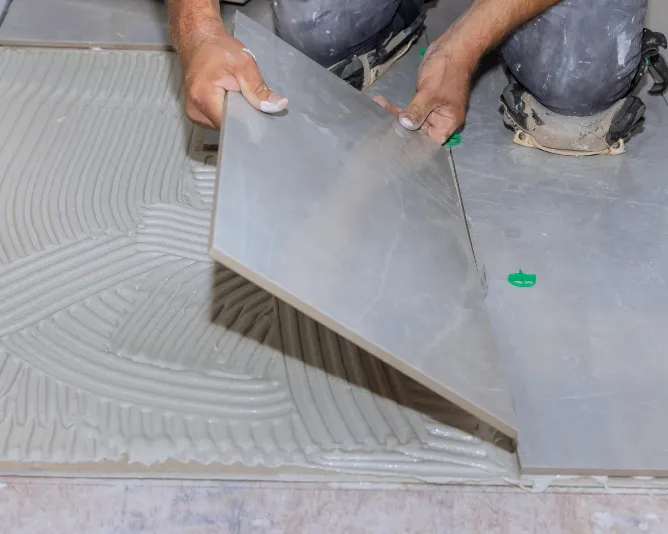Choosing the wrong tile adhesive can turn your dream renovation into a nightmare – let’s make sure that doesn’t happen.
Understanding Different Types of Tile Adhesives
When it comes to tiling projects, selecting the right adhesive is crucial for achieving a lasting, professional finish. As experienced tilers in Bromley, we’ve encountered numerous situations where improper adhesive selection has led to costly repairs. The key to success lies in understanding the various types of adhesives available and their specific applications. Each type offers distinct advantages and limitations that make them suitable for different scenarios.
Thinset Mortar: The Versatile Standard
Thinset mortar, also known as cement-based adhesive, is the most widely used option in the UK market. This versatile adhesive provides exceptional bonding strength and moisture resistance, making it ideal for both indoor and outdoor applications. Studies show that properly applied thinset mortar can maintain its bond strength for over 50 years. The cement-based formula creates a mechanical and chemical bond with the substrate, ensuring tiles stay firmly in place even under challenging conditions.
- Excellent water resistance – perfect for bathrooms and outdoor areas
- Superior bonding strength for heavy tiles
- Cost-effective solution for large areas
- Suitable for both floor and wall applications
- Available in rapid-setting formulations for quick project completion
Modified vs Unmodified Thinset
Modified thinset mortars contain latex polymers that enhance flexibility and adhesion strength. These additives make the adhesive more forgiving on challenging substrates and better suited to modern installation requirements. Recent industry data indicates that modified thinsets account for 75% of professional installations in the UK. The choice between modified and unmodified versions depends largely on your specific project needs and tile type.
- Modified thinset: Ideal for porcelain, large format tiles, and areas with temperature fluctuations
- Unmodified thinset: Best for natural stone and areas requiring traditional installation methods
Mastic Adhesive: Perfect for Wall Tiles
Mastic adhesive offers exceptional convenience for vertical installations, particularly in dry areas. This ready-to-use product is perfect for kitchen backsplashes and bathroom wall tiles where moisture exposure is limited. However, it’s crucial to understand its limitations to prevent installation failures.
- Ready to use straight from the container
- Excellent initial grab for wall tiles
- Not suitable for wet areas or floor applications
- Best for tiles up to 200mm x 200mm
Selecting Adhesive Based on Your Project Type
The success of your tiling project heavily depends on matching the adhesive to your specific application. Different areas of your home present unique challenges that require careful consideration of adhesive properties.
Bathroom and Wet Area Solutions
Bathrooms and wet areas demand adhesives with superior water resistance and long-term durability. According to industry statistics, 80% of tiling failures in bathrooms are attributed to incorrect adhesive selection. We recommend using high-performance modified thinset mortars or epoxy-based adhesives for these challenging environments.
- Use water-resistant modified thinset for general bathroom walls and floors
- Consider epoxy adhesives for steam rooms and wet rooms
- Ensure complete coverage for optimal moisture protection
Kitchen and Backsplash Considerations
Kitchen installations require adhesives that can withstand temperature changes and occasional moisture exposure. While mastic adhesives are popular for backsplashes, modified thinset offers superior long-term performance, especially near cooking areas where temperature fluctuations are common.
Large Format Tile Requirements
The growing popularity of large format tiles presents unique installation challenges. Recent market data shows a 40% increase in large format tile installations since 2022. These tiles require adhesives with enhanced grip and proper support to prevent lippage and ensure even coverage.
Special Application Adhesives
Certain tiling projects require specialised adhesives to achieve optimal results. Understanding these specific solutions ensures successful installation of decorative and high-performance tiling systems.
Glass Tile Adhesive Lite
Glass tile installations demand specific adhesive properties to maintain transparency and prevent show-through. Glass Tile Adhesive Lite provides the perfect solution with its white colour and non-sag properties. This specialised product offers superior bond strength while ensuring the aesthetic appeal of glass tiles remains unmarred.
Epoxy Tile Mortar
For environments requiring maximum chemical resistance and strength, epoxy tile mortar stands as the premium choice. While more expensive than traditional adhesives, its exceptional durability makes it cost-effective for commercial kitchens, industrial facilities, and high-traffic areas.
Common Adhesive Selection Mistakes to Avoid
Drawing from our extensive experience in Bromley and Kent, we’ve identified several common mistakes that property owners make when selecting tile adhesives.
Environmental Factors
- Ignoring temperature requirements during installation
- Failing to account for substrate movement
- Overlooking humidity levels in wet areas
- Not considering external weather exposure
Cost vs Performance Balance
While budget considerations are important, selecting adhesives purely based on price often leads to costly repairs. Industry data shows that using appropriate premium adhesives adds only 5-10% to material costs but reduces callback rates by 60%.
Making Your Final Choice
When selecting your tile adhesive, consider these key factors: substrate condition, tile type, location, and environmental conditions. For complex installations, especially in wet areas or with large format tiles, we strongly recommend consulting professional tilers to ensure proper adhesive selection and application.
Professional Installation Considerations
Professional installation by experienced tilers ensures proper adhesive selection and application techniques. At Bromley Tilers, we pride ourselves on staying current with the latest adhesive technologies and installation methods to deliver superior results for our clients throughout Bromley and Kent.
FAQ
Is it better to put tile adhesive on the wall or on the tile?
Before you place the tiles on the wall, you need to evenly and correctly apply the tile adhesive. It needs to be put on the walls with a trowel at the correct angle and applying the right pressure.
What helps peel and stick tiles stick better?
Apply Firm Pressure To make a lasting impression, once the tile is in place, press firmly to really activate the adhesive. Using a heavy vinyl floor roller (or some sliding dance move action) will help ensure even contact with the floor, preventing lifting or slipping.
How much depth should I allow for tile adhesive?
As a general rule for which size trowel to use, follow this generic banding: Mosaics (10x10cm or smaller) – 3-4.5mm. Large format tiles (20×20-30x30cm) – 8mm.
How to choose the right tile adhesive?
Small ceramic tiles are often used for walls and splashbacks and in most cases, a ready-mixed paste will be suitable for the job. If you’re fixing a larger ceramic tile (larger than 30 x 30 cm) or any size porcelain tile to your walls, you will need to use a powdered adhesive.
What is the difference between mortar and thinset?
While thinset is technically a modified mortar, it’s thinner and designed specifically for tiles, unlike mortar which is thick and holds stacked bricks in place. Likewise, thinset contains cement, but its formula lacks the strength to build walls or even serve as a stand-alone flooring product.
Sources
[1] https://www.laticrete.com/en/products/glass-tile-adhesive-lite
[2] https://www.reddevil.com/products/product/tile-paste-adhesive-squeeze-tube-5-5-fl-oz-squeeze-tube-white
[3] https://www.amcork.com/products/liquid-nails-fuze-it-adhesive



